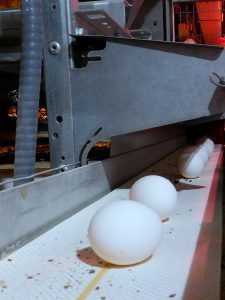9 Factors that Influence Egg Size
 Consumers tend to prefer and are willing to pay more for larger eggs, so knowing what may influence the size of egg produced may be beneficial for maximum return. A large egg is not always a good egg. The larger the egg is, the thinner the eggshell thickness is. A hen will only deposit 2 grams of calcium per egg, regardless of egg size.
Consumers tend to prefer and are willing to pay more for larger eggs, so knowing what may influence the size of egg produced may be beneficial for maximum return. A large egg is not always a good egg. The larger the egg is, the thinner the eggshell thickness is. A hen will only deposit 2 grams of calcium per egg, regardless of egg size.
The following nine factors influence egg size:
Breed
Some smaller breeds produce small eggs due to their body size, while some chicken breeds produce medium to large eggs. Individual hens may not lay an egg that consistently falls within the breed’s average egg size. Geneticists work to create commercial lines that have different size ranges and egg weight is a heritable trait that responds to genetic selection. It is important to select a commercial variety of bird that produces the size of egg you want to produce. However, about 60% of egg size variation is due to non-genetic factors such as nutrition and management.
Ambient Temperature
The ambient temperature of a house has a substantial impact on the size of eggs produced. The eggs produced in hot conditions are often small. Feed consumption declines if the temperature is too hot, therefore hens lay smaller eggs. When the temperature of the house exceeds 27 degrees Celsius (over 80 degrees Fahrenheit) the eggs are smaller.
Lighting Programs
Chickens are responsive to changes in day length. Egg size is influenced by lighting programs in the growing period. Lighting programs can delay or accelerate sexual maturity in pullets. The age in which a chicken starts laying has a significant influence on the egg size. Light stimulation should be done based on the flock’s body weight and uniformity. Later light stimulation and heavier body weights will delay maturity and increase egg size.
Age of hen
The younger the hen, the smaller the egg size. As hens grow older their eggs gradually increase in size. Maximum egg size can be expected when birds reach about on year old. Egg size tends to get smaller again just before birds stop laying.
Feed intake
If all required nutrients are available in correct quantities in the feed, then the higher the feed intake, the larger the eggs. Any factors that may inhibit feed consumption, such as crowding or stress, will reduce egg size. Environmental temperatures above a bird’s thermoneutral zone (>33 degrees Celsius) have a dampening effect on a bird’s feed intake
Water consumption
If a hen does not consume adequate water, it affects the egg size and production. The water quality and temperature are also important. Lower water consumption will mean a reduction in feed consumption too, resulting in smaller eggs.
Body weight and skeletal size
Chickens with higher body weights lay larger eggs, and chickens with smaller body weights produce smaller eggs. Body weight is dependent on a variety of nutrients, light and feed intake. Heavier hens also tend to lay more eggs throughout the production period. Body weight can be affected by many factors including transfer, disease, beak trimming, vaccination, lighting programs, space and nutrition. It is important to reach target body weight with good uniformity before starting light stimulation and achieving sexual maturity
Nutrition
Proper nutrition in the rearing period allows the hen to achieve or exceed standard body weights. During the laying period, diet specifications can be used to manage egg size. Energy, methionine/cystine, other digestible amino acids, linoleic acid and total fat can directly affect the egg size and when supplied correctly, help product larger eggs. If mineral requirements are not met and birds are laying too large eggs, this could result in thinner shells and more cracked eggs. Protein is an essential component of the diet that also needs correctly balanced. Eggs are a high protein food therefore birds also need a good amount of protein in their diet.
Bird Health
Disease, stress, injury, and fear can affect the feed intake of chickens and egg production rate. Prevention of disease is important part of production. Good hygiene, biosecurity practices and management will reduce the risk of infection. Prevention and control of disease is not only critical for quality of eggs but also the success of the whole chicken production
Bonus: Egg Cooling and Storage
It is important to cool eggs as quickly as possible after they are laid and to store them well at a temperature of 50oF to 55oF. If eggs are not stored correctly then they will lose weight by evaporation which may result in poorer grading results and therefore a poor economic return.
Subscribe to our blog!
Sources:
https://www.feedstrategy.com/poultry-nutrition/how-to-increase-egg-weight-through-hen-nutrition/
https://www.livestocking.net/factors-affecting-egg-size
https://blog.meyerhatchery.com/2021/04/why-are-my-hens-laying-small-eggs/
https://www.thepoultrysite.com/articles/optimising-egg-size-in-commercial-layers
https://www.poultryworld.net/poultry/controlling-egg-size/
https://www.feedstrategy.com/poultry-nutrition/how-to-increase-egg-weight-through-hen-nutrition/
https://www.veterinariadigital.com/en/articulos/how-to-increase-egg-size/
